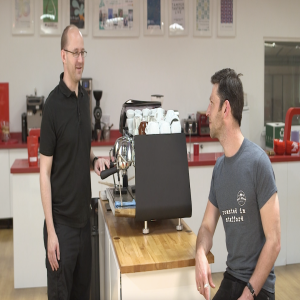Episodes

Saturday Jun 26, 2021
Episode 659: Bolivia Trapiche
Saturday Jun 26, 2021
Saturday Jun 26, 2021
The Trapiche farm is another venture by our friends at Agricafe in the Samaipata region of Bolivia. Pedro Rodriguez and his family also own a handful of other farms in the area (El Fuerte and Samaichacha we've got coffees from this year too!) and a whole host of other farms further afield in Bolivia, such as La Linda and Alasitas, that a lot of you will also be familiar with. We have purchased coffee from Trapiche once previously and it was just a teeny tiny lot that went exclusively to the #SSSSS subscribers (lucky folks!) but this year we've bought more and are super excited to be able to share it with all of you here.
Trapiche's name was inspired by a vineyard of the same name in Argentina that Pedro visited before setting up this new farm in 2016. He and his family love good wine and have drawn on this when developing the design for this land. The word “Trapiche” originally refers to a type of mill made of wooden rollers used to extract juice from fruit such as grapes or olives.
The Rodriguez family are continuously looking for inspiration from other coffee-producing countries and from other industries such as winemaking – Trapiche is an example of this winery inspiration in action. The farm is a truly amazing place and the team have designed it to look and function like a vineyard, using those methodologies to refine their coffee production process. This is particularly fitting as Samaipata is an up and coming wine region within Bolivia, with several small vineyards located only a short distance from Trapiche.
The farm has only been operational since 2016 so it's still very young but the results from the first few harvests are very exciting. Samaipata isn't a traditional coffee growing region but it's one that the Rodriguez family have pioneered. The climate of the Samaipata region is temperate, semi-dry in the winter months, and mild with an average annual temperature of 19.9°C. During the winter months, cold fronts called Surazos come from the Argentine Pampas and enter the plains and valleys of Santa Cruz, these cold winds combined with the altitude can reach temperatures below freezing. In the summer the days are warm and the nights cool, this variation in diurnal temperature causes the cherries to take a longer time to ripen and their mucilage becomes very thick. The local soil contains a lot of magnesium, which is great for growing coffee and means that the coffee plants are less susceptible to roja, or other fungi. All of these factors contribute to a very unique taste profile.
The Rodriguez family are superstars in the world of Bolivian coffee, we think it's fair to say that the landscape of Bolivian coffee production would look a lot different without Agricafe's phenomenal work. Agricafe initially entered the coffee industry in 1986, when Pedro Rodriguez decided to pursue his passion for agriculture. Now they produce coffee from their own farms in the La Paz and Santa Cruz departments, source high-quality micro-lots from small local producers, and carry out the processing of everything at their state of the art mills. The steady decline of coffee production in Bolivia has put the sustainability of the family's business in jeopardy. Without the intervention of people like the Rodriguez family, the future of coffee production in Bolivia is at risk of disappearing. It's an expensive place to grow coffee, which means that the specialty market is the only sustainable model – higher quality means that producers can demand higher prices for their harvest. Alongside the exceptional work at their own farms and mills the Rodriguez family run the Sol De La Manana project, which seeks to educate local producers by providing agronomical expertise to improve the quality of their farms, and the Qhatu Café program which sources from small Organic producers to assure them a market for their coffee. In their own words, “In line with our values, it is very important to us to improve Bolivian Coffee culture and to diversify Bolivian coffees. Therefore, we believe we have to work together as a team with local producers of the regions where we produce. We aim for a sustainable coffee production in the long term, and this is why we decided to found two social programs in the area of Caranavi, supporting over 500 families in the region.”
This year's harvest was trickier than usual because of the impact of Covid-19 but thankfully there were still enough staff available to safely complete the harvest as needed. Once picked, all of the cherry grown locally goes next door to the El Fuerte mill to be processed. Processing is one of the many things that the Rodriguez family do exceptionally well and they run a very strict, controlled environment that is thoughtful and thorough. In recent years they have been focused on ways to innovate their processing methods to explore the range of flavours inherent to Bolivian coffee. Normally processing methods are led by what's cheap and easy to carry out locally, the Rodriguez family's way of doing things is right at the other end of the spectrum, doing difficult things to see what's possible. They are not seeking to mimic the flavour profiles of other well-known producing countries or processing methods, making their coffees taste like other traditional Naturals or Honeys for example, rather they want them to be noticeably Bolivian and celebrate the terroir of the different regions they are growing in. They believe that this extra effort is worthwhile for the exploration of what's possible with Bolivian coffee, and consequently expanding it's market in the specialty world.
In previous years the Rodriguez mills were focussed on looking for ways to innovate the drying phase of processing, this was what gave us the “Coco Natural” coffees that we've been buying for the past 4 years. Now they have moved their attention to the washing stage, taking their lead from the methodologies used on well-respected coffee farms outside Bolivia and from other industries. After harvest, traditionally all coffee cherries would be put through a mechanical depulper to remove the outer skin and flesh of the fruit and then through a scrubber, resulting in very clean beans that then go on to be dried. The alternative to mechanical removal is fermentation, where the cherries are submerged in water tanks and natural fermentation causes the fruit to break down in order to be removed. With this lot we see a combination and evolution of both, termed “Anaerobic Washed” by Agricafe. You might have seen other coffees that use terms like “Anaerobic” and “Lactic” from other places but it's worth noting that these are currently somewhat vague terms as there's no continuity or set definition between producers/countries – it's important to dig a bit deeper to find out what these words really mean in each instance. Don't expect this coffee to taste like an Anaerobic lot from Costa Rica, it's a totally different kettle of fish! After being brought to the mill this coffee was rinsed to remove dirt and then put through a mechanical depulper, then placed into tanks of water to ferment. These tanks are sealed with a breather valve (hence the “Anaerobic” part of the name in this case) and are maintained at a constant temperature for a set period of time, with the goal being to drop the pH very low and maintain this throughout the fermentation.
The team at the mill have done small scale trials in the past with encouraging results and now we get to taste it - we think the results are really stellar but they are still developing and experimenting, no resting on their laurels for these guys!
The first thing that leaps out is how smooth and silky this coffee is. That beautiful texture is backed up by sweet dark toffee and chocolate flavours, with a red apple acidity balancing it out.
- Country: Bolivia
- Region: Samaipata
- Department: Santa Cruz
- Farm: Trapiche
- Farm size: 17 hectares
- Farmer: The Rodriguez family
- Altitude: 1,600–1,800 m.a.s.l.
- Variety: Bourbon
- Process: Anaerobic Washed
CUPPING NOTES
Dark toffee, chocolate, red apple.
Clean cup (1–8): 6
Sweetness (1–8): 7
Acidity (1–8): 6
Mouthfeel (1–8): 8
Flavour (1–8): 6.5
Aftertaste (1–8): 6
Balance (1–8): 6.5
Overall (1–8): 6.5
Correction (+36): +36
Total: (max. 100): 88.5
Roast Information
Medium-dark - through first and let this get some development, but dropping the roast just as you approach 2nd crack.

